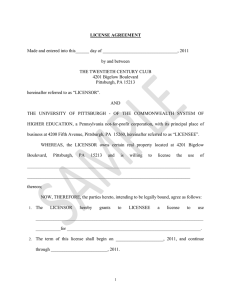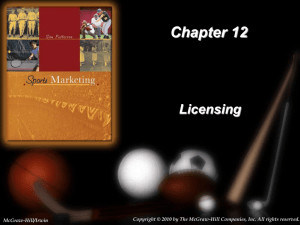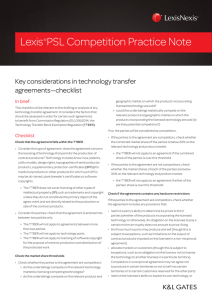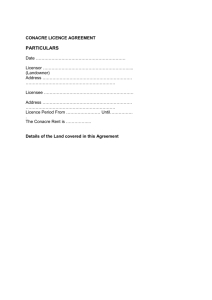Lexis PSL IP&IT Practice Note Key IP considerations in vertical agreements-checklist
advertisement
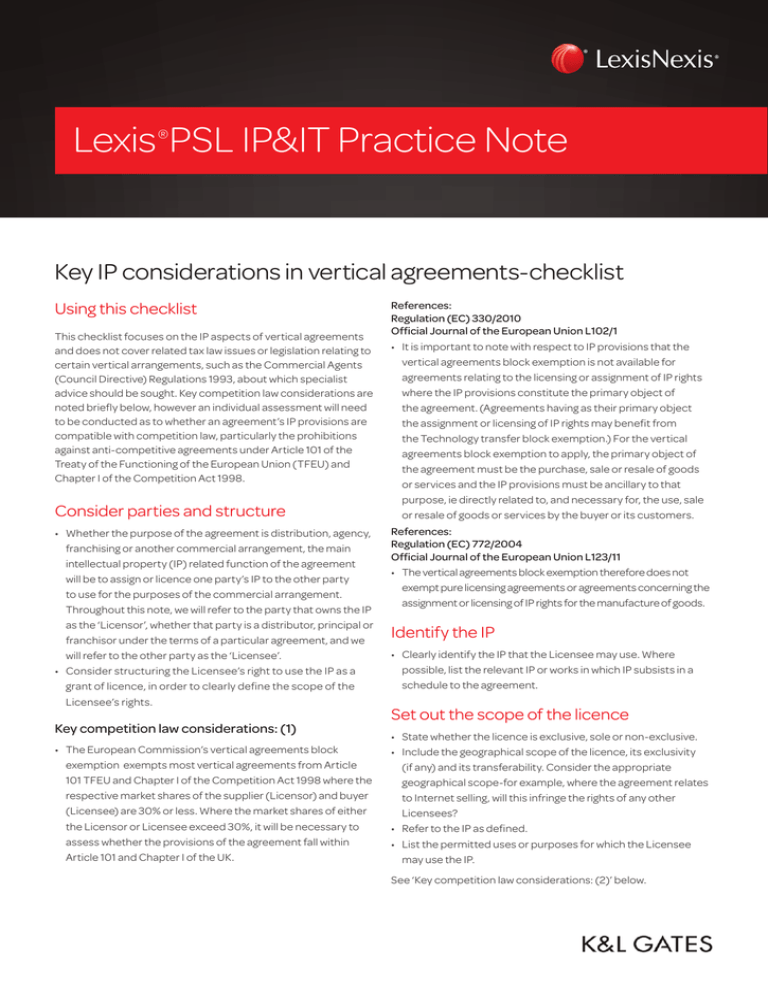
Lexis PSL IP&IT Practice Note ® Key IP considerations in vertical agreements-checklist Using this checklist This checklist focuses on the IP aspects of vertical agreements and does not cover related tax law issues or legislation relating to certain vertical arrangements, such as the Commercial Agents (Council Directive) Regulations 1993, about which specialist advice should be sought. Key competition law considerations are noted briefly below, however an individual assessment will need to be conducted as to whether an agreement’s IP provisions are compatible with competition law, particularly the prohibitions against anti-competitive agreements under Article 101 of the Treaty of the Functioning of the European Union (TFEU) and Chapter I of the Competition Act 1998. Consider parties and structure • Whether the purpose of the agreement is distribution, agency, franchising or another commercial arrangement, the main intellectual property (IP) related function of the agreement will be to assign or licence one party’s IP to the other party to use for the purposes of the commercial arrangement. Throughout this note, we will refer to the party that owns the IP as the ‘Licensor’, whether that party is a distributor, principal or franchisor under the terms of a particular agreement, and we will refer to the other party as the ‘Licensee’. • Consider structuring the Licensee’s right to use the IP as a grant of licence, in order to clearly define the scope of the Licensee’s rights. Key competition law considerations: (1) • The European Commission’s vertical agreements block exemption exempts most vertical agreements from Article 101 TFEU and Chapter I of the Competition Act 1998 where the respective market shares of the supplier (Licensor) and buyer (Licensee) are 30% or less. Where the market shares of either the Licensor or Licensee exceed 30%, it will be necessary to assess whether the provisions of the agreement fall within Article 101 and Chapter I of the UK. References: Regulation (EC) 330/2010 Official Journal of the European Union L102/1 • It is important to note with respect to IP provisions that the vertical agreements block exemption is not available for agreements relating to the licensing or assignment of IP rights where the IP provisions constitute the primary object of the agreement. (Agreements having as their primary object the assignment or licensing of IP rights may benefit from the Technology transfer block exemption.) For the vertical agreements block exemption to apply, the primary object of the agreement must be the purchase, sale or resale of goods or services and the IP provisions must be ancillary to that purpose, ie directly related to, and necessary for, the use, sale or resale of goods or services by the buyer or its customers. References: Regulation (EC) 772/2004 Official Journal of the European Union L123/11 • The vertical agreements block exemption therefore does not exempt pure licensing agreements or agreements concerning the assignment or licensing of IP rights for the manufacture of goods. Identify the IP • Clearly identify the IP that the Licensee may use. Where possible, list the relevant IP or works in which IP subsists in a schedule to the agreement. Set out the scope of the licence • State whether the licence is exclusive, sole or non-exclusive. • Include the geographical scope of the licence, its exclusivity (if any) and its transferability. Consider the appropriate geographical scope-for example, where the agreement relates to Internet selling, will this infringe the rights of any other Licensees? • Refer to the IP as defined. • List the permitted uses or purposes for which the Licensee may use the IP. See ‘Key competition law considerations: (2)’ below. Key IP considerations in vertical agreements-checklist Place restrictions on the use of the IP • If structuring the right to use the IP as a grant of licence, draft the restrictions clause so the grant of licence is an exception to the restrictions. This ensures that the Licensee may only use the IP for the permitted uses or purposes listed in the grant of licence. • The restrictions should also extend to third parties-the Licensee should not authorise or permit any third party to carry out restricted acts or omissions in relation to the IP. Key competition law considerations: (2) • EU and UK competition law accept that some contractual limitations may be necessary to protect IP rights. For example, the vertical agreements block exemption permits certain territorial restrictions (eg an exclusive trade mark licence amounts to a permissible exclusive distribution agreement, provided it complies with the other competition conditions), and certain restrictions relating to the treatment and use of IP. References: COMMISSION NOTICE: Guidelines on Vertical Restraints (SEC (2010) 411) • However, contractual restrictions which go beyond that which is necessary for, and ancillary to, the use, sale or resale of goods or services by the Licensee or its customers under the agreement may fall foul of competition law. • In addition, care should be taken to ensure that any IP restrictions do not involve restrictions on competition with the same object or effect as: • ‘hardcore restrictions’, which include (among others) pricefixing restrictions, including resale price maintenance. For example, advice may need to be sought where price-marked packaging is required to be used by the Licensee; or • ‘non-exempted vertical restraints’, which include (among others) certain territorial or customer restrictions. For example, licensing provisions may potentially be of concern where they restrict the Licensee’s ability to compete outside its licensed field of use. Some restrictions to consider on the use of IP (subject to the considerations set out above in ‘Key competition law considerations: (2)’): • Prohibition on the Licensee using the IP for any purpose other than that set out in the agreement. • Prohibition on the Licensee from dealing with the IP-copying, selling, licensing, sub-licensing, distributing, transmitting, duplicating, publishing, other than as may be required to fulfil the purpose. • Restriction from removing any Licensor’s ownership or attribution notices that should appear with the IP. • Prohibition on reverse engineering, decompiling, altering or tampering with the IP, as applicable, (except where decompilation of a computer program is required to make it interoperable with other hardware or software). • Prohibition on the Licensee from registering the IP or confusingly similar IP (particularly trade marks). • Prohibition on Licensee from using any similar IP. • Prohibition on the Licensee from doing anything that might invalidate the IP or damage its goodwill. • In the case of a selective distribution system for luxury goods, restrictions on selling products incorporating the IP outside of the permitted channels. Acknowledgement of IP ownership • Include an acknowledgement by the Licensee of the Licensor’s ownership of the IP and where applicable, goodwill in the IP. • Consider which party will own any IP created from the licensed IP and make provision for this in the agreement. • Consider whether the Licensee should be permitted to register IP on the Licensor’s behalf and who is responsible for fees. • Include a clause reserving all rights in the IP to the Licensor, other than those expressly granted to the Licensee, and making it clear that nothing in the agreement transfers any title to, or rights in, the IP to the Licensee. Third party IP included within Licensor’s IP • If the Licensor’s IP includes any third party’s IP or requires third party IP in order to be used, ensure that the Licensor can grant the Licensee a licence to use the third party IP, or include an obligation on the Licensee to obtain a licence from the third party. Audit • Consider including an audit provision. Depending on the particular commercial arrangement between the parties, audits could be performed on the Licensee’s accounts to ensure that correct fees are being paid, or on the Licensee’s operations to ensure that the IP is being used only in accordance with the terms of the licence. Protection of Licensor’s IP • Include attribution wording and ownership notices and a requirement that the Licensee always uses these in publications or when displaying or manufacturing works containing the IP. • Include a requirement for the Licensee to use appropriate symbols in ownership notices or in conjunction with the IP, ie use ® to denote a registered trade mark. • Include guidelines for the use of the IP to which the Licensee must adhere, eg a trade mark style guide. • If appropriate, include a right for the Licensor to approve any advertising, marketing materials, packaging or other external publications regarding or incorporating the IP. • Depending on the relative positions of the parties, consider including an obligation on the Licensor to keep its IP registrations and consents up to date. Key IP considerations in vertical agreements-checklist • Include an obligation for the Licensee to inform the Licensor or any actual, threatened or suspected infringement of the IP of which the Licensee becomes aware. • Include a procedure for the parties to deal with detected IP infringement, for example, a requirement that the Licensor takes action, and consider which party will fund the action or whether litigation costs should be split. In the case of an exclusive IP licence, consider the statutory application of who has the right to sue and whether this should be displaced. • Consider a right for the Licensor to immediately suspend the Licensee’s rights to use the IP or to require the immediate withdrawal of any advertising or external publications regarding or incorporating the IP, for example, where the Licensee’s actions harm the validity of the IP, or damage the Licensor’s reputation. • Consider whether there should be an obligation on the Licensee of trade marks to use the mark in a particular territory, in order to avoid challenges to the trade marks on the grounds of non-use. Further assurance • Include an obligation on the Licensee to enter into documentation or carry out any required action to protect the Licensor’s IP, or vest IP or goodwill in the Licensor, and consider whether this should be a mutual obligation. • Consider which party will fund any further assurance requiredit is usually the Licensor, as the actions will most often benefit the Licensor. Liability • Consider the relative liability position of the parties in relation to the IP and draft liability exclusions and caps according to what is reasonable in the circumstances. Term and termination • Consider how long the agreement should last and whether it should automatically renew. • Consider including rights for the Licensor to terminate the agreement if the Licensee: • is in material breach of its obligations, providing an appropriate period of time for the Licensee to remedy a breach capable of being remedied before termination becomes effective. • becomes insolvent or enters into winding up or bankruptcy proceedings. • undergoes a change of control. This enables the Licensor to keep control over its IP, for example, in the event that the Licensee is taken over by a competitor of the Licensor. • does or allows anything to be done that harms or invalidates the Licensor’s IP. • attempts to assign, transfer or otherwise deal with the Licensee’s rights to the IP. • contests the Licensor’s ownership of the IP being licensed. • Consider any appropriate rights for the Licensee to terminate, including termination in the event of an IP infringement. Post-termination • Upon termination, the Licensee should immediately stop using the IP, and if possible, take steps to distance itself from the Licensor. • Ensure that works containing the IP are returned to the Licensor or destroyed upon termination. • Include a clause to say that termination of the agreement will not affect any accrued rights or liabilities that the Licensor may have at the date of termination. This ensures that the Licensor can still pursue action against the Licensee for breach of the Licensor’s IP, even if the agreement has ended. • Set out the clauses that will survive termination of the licence. These should include the IP ownership clause and restrictions on the Licensee in relation to the IP, where appropriate. Key competition law considerations: (3) • o Ensure that any post-termination IP provisions do not amount (directly or, more likely, indirectly) to non-compete provisions which are not exempt under the vertical agreements block exemption (eg an obligation extending beyond 5 years which indirectly causes the Licensee not to manufacture, purchase or resell goods or services competing with the contract goods or services). Warranty • Consider what warranties and disclaimers of warranty the Licensor should give in relation to the IP. It is common to warrant that the Licensor’s IP will not infringe the IP of any third party, equally it is also common to see a disclaimer of this warranty. • Consider whether to warrant the validity or enforceability of the IP, or whether to disclaim any warranties of this type. • Consider as an alternative or in addition to, a warranty against third party IP infringement, a warranty that the Licensor has the right to grant the rights to the Licensee to use the IP or a warranty that the Licensor owns the IP. Indemnity • Consider whether to include an indemnity in favour of the Licensee in the event of a claim that the Licensor’s IP infringes the IP of a third party. Confidentiality • Ensure that the information covered by the confidentiality clause is defined widely enough to capture information required to operate the IP, and that the confidentiality clause survives termination of the agreement. Key IP considerations in vertical agreements-checklist Rights to assign, sub-contract, transfer • Consider whether to restrict the Licensee’s rights to assign, sub-contract or transfer its rights and obligations under the agreement to a third party, as this could result in another party having rights to the Licensor’s IP. Regard should be had, when delineating the Licensee’s rights, to the competition law considerations noted above in ‘Key competition law considerations: (2)’. Reed Elsevier (UK) Limited trading as LexisNexis. Registered office 1-3 Strand London WC2N 5JR Registered in England number 2746621 VAT Registered No. GB 730 8595 20. LexisNexis and the Knowledge Burst logo are trademarks of Reed Elsevier Properties Inc. © LexisNexis 2015 0815-014. The information in this document is current as of August 2015 and is subject to change without notice.
